New 17-Pitch Route on Heart Mountain in Rockies
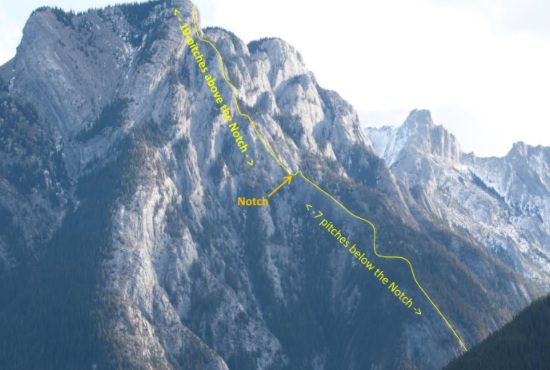
Heart Mountain is one of the Canadian Rockies most popular peaks. There is a casual hike to the top, Heart Canyon to the west has dozens of quality routes and on the east face is the world-famous Acephale.
British climber Chas Yonge, who has been in Canada for decades developing climbs, has pieced together parts of an old project and often-looked-at terrain on the west face of Heart into a 17-pitch 5.9 A0 called Heart Line, which will surely be one of the more popular routes around.

The route is broken up into sections and requires some hiking through a forest, similar to the classic Angel’s Crest 5.10c in Squamish.
Below is a report from Yonge, who had developed many routes in the Rockies and published a guidebook to Kid Goat.
“Over the years a number of climbers have wondered about a rock route up Heart Mountain. The first mention that I’m aware of is in Chris Perry’s Bow Valley Rock where Steve DeMaio with A. and D. St Pierre climbed the last wall which they accessed via a 20-minute traverse from below the boulder problem move on Heart Mountain Trail.
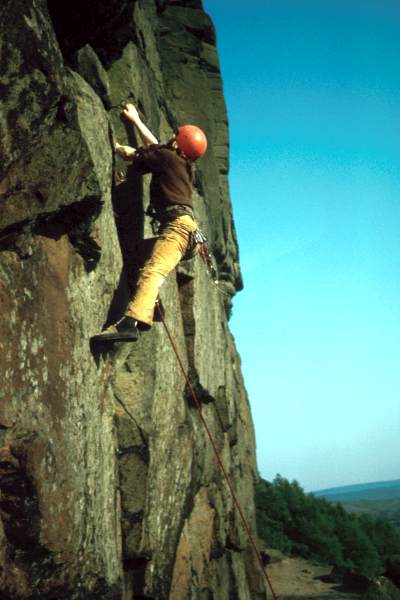
“They climbed the wall in two pitches calling it St Pierres’ Summit (5.6 and 5.7 – November 1995). Chris comments that “additional pitches could be climbed lower down, possibly making an interesting integral type of climb.”
“The Heart Line realizes Chris’s musings. It does climb lower pitches all the way from Heart Creek, only uses a short section of their second pitch and is otherwise independent. Round about the same time, Dwayne Congdon and partner attempted a trad ascent that climbed somewhere through the lower slabs, past the Notch, but bailed at the top of pitch 12, leaving two self-drive bolts there.
“The most recent activity on the route (September 2002) was by Kelly MacLeod and Fred Sampson who bolted Black Roll Over having come up from routes on Heart Slabs (Heart Line makes use of the top two pitches).
“They also placed two-bolt stations on the top of the walls above, which are also used by Heart Line. I started the Heart Line ‘project’ in October 2016 when Chris Perry and I, scrambling up from Heart Creek, worked on pitch two.
“But I started in earnest (from March 2017) carting rope and gear up the Heart Mountain scramblers trail, working from the top downwards, with many long days, once coming out under moonlight at midnight after a bit of an epic.
“Chris Perry and I have now made the first ascent (June 2017). It has been quite an adventure and hopefully now to be enjoyed by many climbers.
“In fact a few have made the ascent and have given me constructive, favourable feedback. Heart Line goes at 5.9 A0 and you gain 1,100 metres.
“It can be described as a sport mountaineering adventure which takes you from Heart Creek to the mountain summit Great views on the way. For gear: 12 quick draws, two long slings.”
Route Description: Start left of Bunny Hill and immediately left of the water streak/ice climb. This is easily accessed by staying on the left side of the creek at the fifth bridge 100 metres downstream of Bunny Hill.
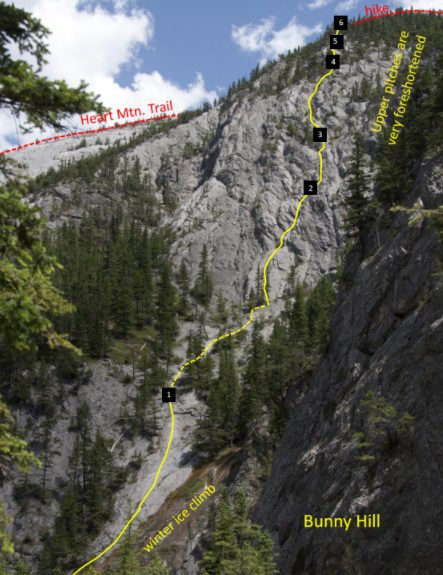
Pitch 1: Climb the slab (bolt to start) immediately left of the water streak. Move slightly left to gain a steeper, dry water course scoop and up this to a 2-bolt belay. (5.4 9 clips 55m)
Class 4: Scramble on rock up to the base of the large slabby face. (40m)
Pitch 2: Starting at the low point on the slabby face, gain a clean rounded arête ending at a ledge. Leave the ledge and move right above, then go straight up the face to a 2-bolt belay. (5.6 12 clips 55m)
Pitch 3: Climb a faint arête on left and then on excellent light-coloured rock on the right side of a hanging gully. Step into the gully at the top, moving up a few metres up it to a face on the left. Go up this (3 clips) to arrive at a 2-bolt station. (5.6 10 clips 45m)
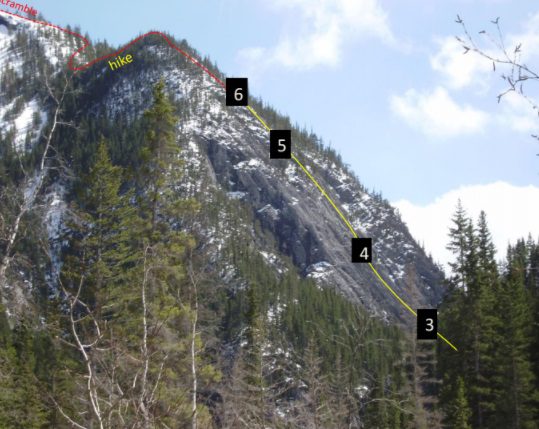
Pitch 4: Climb the slab above the belay (3 bolts) – take care with loose scree on ledge above – then continue up a discontinuous series of slabs to easy ground then one move up a groove to a 2-bolts stance – a full pitch. (5.6 9 clips 60m)
Pitch 5: Climb a short slab (1 bolt) then move up to a longer slab (4 bolts). A further long slab takes you to easy ground and a comfortable tree belay with flat-rock seat. (5.6 8 clips 40m)
Pitch 6: Climb the slab above (4 bolts) and then scramble up 4m to a comfortable stance at a gnarled tree. (5.3 4 clips 33m)
Class 3 & Hiking: Having packed away climbing gear and shoes, walk steeply up for about 100m to gain the pleasant, level ridge with a small saddle. From the saddle, hike up 50m and take an animal trail diagonally up to the right.
This takes you up to the open ridge. Continue up enjoyably, admiring the spectacular views all around. Scramble the first rock band (class 3) passing two prominent dead trees and continue easily across kinnikinik meadows until the final rock band. Scramble up this for 30m until reaching a pinnacle. (400m with about a 180m height gain)
Pitch 7: Climb the prominent corner to flat top and trees. Walk and end by down-climbing a couple of moves into the notch – protected by a sling on a tree. Confident climbers can readily solo to the notch in hiking shoes. (5.2 2 clips 40m)
Pitch 8: Climb the clean 10m face with nice moves past 4 bolts and scramble up the ridge above to a 2-ring anchor. This is the start of the prow that takes you all the way to the summit. (5.7 4 clips 35m)
Pitch 9: Move left and step up onto the large slab (Black Intrusions Slab – BIS). Continue rising leftwards up past 2 bolts to a 2-ring anchor (to join Black Roll Over – see topo & acknowledgements). (5.2 2 clips 20m)
Pitch 10: Go up the BIS slab to a 2-ring anchor; an excellent pitch on superb rock. (5.6 5 clips 30m)
Pitch 11: Continue up the big slab to a 2-bolt anchor at the top of the slab. (5.5 4 clips 25m)
Class 3: Scramble on up the prow until barred by a prominent buttress. (30m)
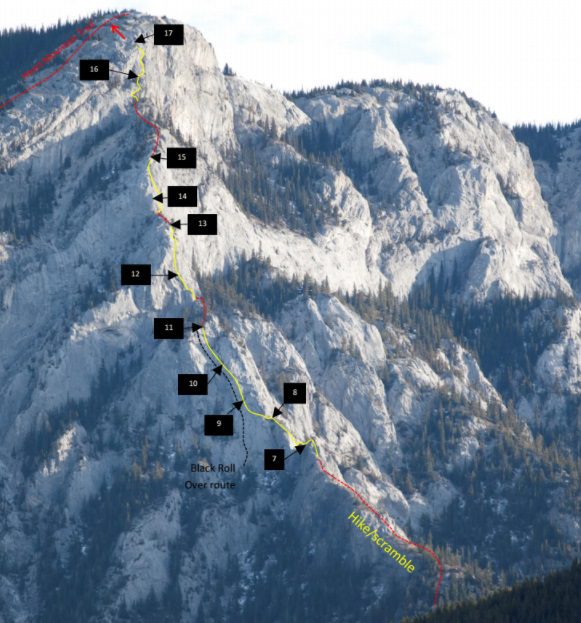
Pitch 12: From a belay bolt, step left and climb the left-facing corner, then right to a right- facing corner (loose rock). This takes you to a 3-bolt belay (one new) and face above. (5.7 3 clips 25m)
Pitch 13: Make a steep thin move off the belay and continue up a narrow right-facing corner on good jugs. Going up and slightly left, gain a left-facing corner and at its top make an awkward move to gain a horizontal traverse back right. Then go easily up a right-facing corner to a 2-ring anchor – a good pitch. (5.9 6 clips 28m)
Class 4: After a couple of moves, scramble on up the ridge to the base of the next buttress. (30m)
Pitch 14: Swing up a steep, blank wall using 6 bolts for aid (how many do you need?). Pull out of this via a free-climbing move and easily up to a narrow ledge to a 2-ring belay. (5.7 A0 7 clips 15m)
Pitch 15: Go easily up and pull into a hanging corner/groove. Exit this after a few metres to gain the left face (crux). Go easily up the face and on to a 2-ring belay. (5.8/5.9 5 clips 25m)
Class 4: After a couple of moves, scramble on up the ridge to the base of the final wall. (90m)
Pitch 16: Go up and left (bolt) to gain a traverse back right. At the end of this, pull out onto a sloping, vegetated ledge and up to a 2-ring anchor. (5.5 3 clips 20m)
Pitch 17: Climb rightwards then up to a ledge. Exit the ledge at its right end, then back leftto gain a final ledge and 2-ring anchor. A short scramble and walk from here brings you to the Heart Mountain descent/loop trail, which offers the best descent option, however, a rappel route down is also described below. (5.7 5 clips 27m)
Route options: As Heart Line is a longish day; parts of it can be done as shorter alternatives:
- The first 6 pitches out of Heart Creek could be done as a moderate 5.6 route descending via the 3 rappels down Heart Slabs.
- Hike up to the “boulder step” on the Heart Mountain scrambling trail, then 20-30 minutes rightwards to the
NW shoulder of the mountain. Rappel 8 pitches from the shoulder to the Notch and then climb the last 10 pitches of Heart Line to the summit.
Heart Line Rappel option (the route can be descended by rappel on a single 60m rope)
- Pitch 17 – 20m from rings
- Pitch 16 – 20m from rings
- Pitch 15 – 30m from tree (easier) or down-climb to 2-ring anchor and 25m rap.
- Pitch 14 – 10m to ridge, and easier to stay on rappel to top on pitch 7’.
- Pitch 13 – 30m from tree to ring station or 25m rap from 2-ring anchor.
- Pitch 12 – 30m to ridge and stay on rappel to top on pitch 5’.
- Pitch 11 – 25m to rings on slab
- Pitch 10 – 25m to rings on slab
- Pitch 9 – 20m diagonally to rings above the Notch
- Notch belay – 30m south (climber’s right) down gully onto scree. Scramble down the scree for a further 10m to a tree rappel.
- 30m down slab to base. Then hike down a couple of scree fields and then rightwards horizontally on a sheep trail that follows the base of crags below the Notch until back on the ridge. Hike down to the Saddle. From the Saddle hike leftwards down a broad gulley (West) to the top of Heart Slabs. Go left slightly to 3 tree rappels i.e.
- 25m down slab to next tree rappel.
- 20m to a prominent tree rappel.
- 30m down the slab for 15m then into and down gulley for 15m. Easy down-climbing for 10m brings you to the Heart Slabs trail – a good trail.
Watch Dave Graham make the second ascent of Bunda de Fora 5.14d on Heart Mountain, first sent by Lev Pinter. It is one of the hardest routes in Canada.


